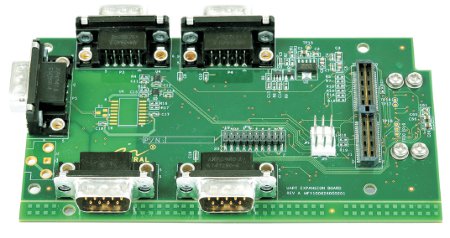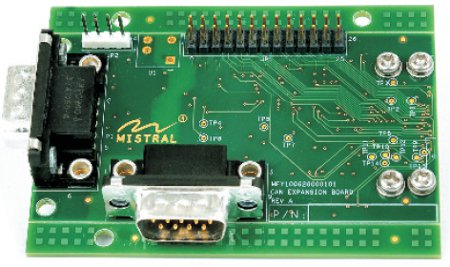Daughtercards expand I/O for TI’s programmable ARM9 SoCs
Sep 1, 2010 — by Eric Brown — from the LinuxDevices Archive — 8 viewsMistral announced two Linux-ready daughtercards for Texas Instruments (TI) evaluation modules (EVMs), the latter already available with the chipmaker's ARM9-based Sitara AM1x and OMAP-L1x SoCs (system-on-chips) on board. The UART Expansion Module offers interfaces for soft UART, hard UART, and soft DIR, while the CAN Expansion Module provides soft CAN, and hard CAN bus interfaces.
Mistral's daughter cards are designed to work with several fairly recent TI system-on-chips (SoCs) built around ARM9 cores that target a range of low-power, low-cost embedded applications. These include the Sitara AM1808, announced this April, as well as the company's OMAP-L137 (late 2008), and the more fully featured OMAP-L138 (June 2009).

Mistral's UART Expansion Module
(Click to enlarge)
Neither platform offers hard interfaces for CAN bus, although they supply a wide variety of other interfaces ranging from USB to I2C.
The AM1808 is the most fully featured of the Sitara AM1x line, which also includes the AM1806, AM1707, and AM1705. Clocked at up to 450MHz, the AM1808 provides Ethernet, SATA support, and dual USB interfaces, in addition to other I/O.
The OMAP-L137 lacks the newer OMAP-L138's SATA storage and DDR2 memory support. It also omits other L138 features such as a MCBSP (multi channel buffered serial port), parallel port, and VPIF video interface.
Mistral's UART and CAN Expansion Modules for the AM1x and OMAP-L1x processors target embedded industrial, medical, automotive, and consumer designs that need to add CAN connections or more UART interfaces. The daughter cards do this by exploiting a peripheral sub-system common to both SoC platforms called the Programmable Real-time Unit (PRU).
The PRU was not initially identified in the OMAP-L1x SoCs, but as shown in the updated block diagram below, has apparently been added or activated since then.
OMAP-L138 block diagram, showing PRU sub-system on the lower right
(Click to enlarge)
In addition, the PRU offloads processing duties from the ARM9 core, thereby improving application processing capacity, reducing power consumption, eliminating latency, and improving real-time responsiveness, TI claims. The PRU can manipulate packed memory mapped data structures and implement system features that have tight real-time constraints, says TI.
The UART daughtercard supports both the OMAP-L137 and the OMAP-L138, but the CAN module supports only the more fully featured L138 model. Both modules also support the AM1808.
Designed to fit into EVM boards offered by TI for the various processors, the daughtercards accelerate the development cycle by providing the source code for the PRU, says Mistral. Both daughtercards are said to ship with Linux drivers, the company adds.
UART Expansion Module
The UART Expansion Module (pictured farther above) is designed for applications requiring multiple hard and soft UART interfaces. Measuring 5.2 x 2.56 inches (132.08 x 65.02mm), the daughtercard is equipped with UART transceivers that are driven by McASP Serializer signals for three Soft UARTs and one hard UART controller with flow control signals, says Mistral.
The UART module is now available with TI's OMAP-L138 and OMAP-L137 EVMs. It is also available separately for integration onto existing EVMs for both, as well as for the AM1808 EVM, says Mistral.
Interfaces are routed to the EVM's board-to-board connectors, connecting to the J30 connector on the OMAP-L138 EVM and the P11 connector on the OMAP-L137 EVM. Connection details were not provided for the AM1808 EVM.
CAN Expansion Module
The CAN Expansion Module from Mistral is available with the OMAP-L138 EVM, but also supports integration onto the AM1808 EVM, says Mistral. The daughtercard interfaces are routed to the board-to-board connectors, and connect to the J28 connector on the OMAP-L138 EVM.

CAN Expansion Module
In addition to offering the daughtercards, long-time TI partner Mistral provides development and customization services to customers planning to build devices around the Sitara and OMAP platforms, says the company.
Stated Samyeer Metrani, vice president, Services (USA), Mistral, "Our two daughtercards for TI's AM1x and OMAP-L1x lines of processors allow developers to leverage the PRU functionality, thereby helping customers build solutions targeted at the industrial and automotive markets."
Stated Sean Murphy, marketing manager, Sitara, TI, "By working with Mistral to develop the daughtercards and software, customers can enjoy benefits including low customer development costs and improved connectivity."
Availability
The UART and CAN Expansion Modules are available from both Mistral and TI for $72 and $77 respectively, with four to six weeks expected for delivery.
More information on the UART Expansion Module may be found here. More information on the CAN Expansion Module may be found here.
This article was originally published on LinuxDevices.com and has been donated to the open source community by QuinStreet Inc. Please visit LinuxToday.com for up-to-date news and articles about Linux and open source.